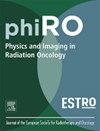Potential of automated online adaptive proton therapy to reduce margins for oesophageal cancer
IF 3.3
Q2 ONCOLOGY
引用次数: 0
Abstract
Background and purpose:
Proton therapy for oesophageal cancer is administered over multiple fractions, based on a single pre-treatment image. However, anatomical changes can lead to the deterioration of the treatment plan, necessitating manual replanning. To keep this within limits, increased residual margins are employed. This study aimed to evaluate the proposed automated Online Adaptive Proton Therapy (OAPT) strategies on their capability to reduce the need for manual replanning, while also exploring the possibility of margin reduction.
Materials and methods:
Two automated OAPT methods were examined: Automated Dose Restoration (ADR) and Automated Full Adaptation (AFA). ADR makes use of dose restoration, restoring the original dose map based on the patient’s altered anatomy. AFA adapts the contours used for plan optimization by applying a deformation field, not only correcting for density changes, but also for the relative location of organs. A comparative analysis of OAPT strategies, evaluating tumour coverage on 17 patients, was conducted.
Results:
The nominal results of non-adapted plans with 7 mm residual margins required manual replanning for 18% of the patients. ADR reduced this to 6%, while AFA eliminated the need for manual replanning. With 2 mm margins, 47% of cases required manual replanning. ADR reduced this to 18%, and AFA further reduced it to 11%.
Conclusions:
The proposed OAPT strategies offered a marked improvement compared to a non-adaptive approach. ADR and AFA significantly reduced the necessity for manual replanning and facilitated the reduction of residual margins, enhancing dose conformity and reducing treatment toxicity.
自动在线自适应质子治疗减少食管癌切缘的潜力
背景和目的:食管癌的质子治疗是基于单个治疗前图像的多个部分进行的。然而,解剖改变可导致治疗方案的恶化,需要人工重新规划。为了使其保持在一定范围内,增加了剩余利润。本研究旨在评估拟议的自动在线自适应质子治疗(OAPT)策略在减少人工重新规划需求方面的能力,同时也探讨了减少切缘的可能性。材料和方法:研究了两种自动化OAPT方法:自动剂量恢复(ADR)和自动完全适应(AFA)。ADR利用剂量恢复,根据患者改变的解剖结构恢复原始剂量图。AFA通过施加变形场来调整用于平面优化的轮廓,不仅可以校正密度变化,还可以校正器官的相对位置。对17例患者进行OAPT策略的比较分析,评估D98%的肿瘤覆盖率。结果:有7毫米残差的非适应性方案的名义结果需要对18%的患者进行手动重新规划。ADR将这一比例降至6%,而AFA消除了人工重新规划的需要。对于2mm的间隙,47%的病例需要手动重新规划。ADR将其降低至18%,AFA进一步降低至11%。结论:与非适应性方法相比,拟议的OAPT策略提供了显着的改善。ADR和AFA显著减少了人工重新规划的必要性,有助于减少残余间隙,提高剂量一致性,降低治疗毒性。
本文章由计算机程序翻译,如有差异,请以英文原文为准。
求助全文
约1分钟内获得全文
求助全文
来源期刊

Physics and Imaging in Radiation Oncology
Physics and Astronomy-Radiation
CiteScore
5.30
自引率
18.90%
发文量
93
审稿时长
6 weeks
 求助内容:
求助内容: 应助结果提醒方式:
应助结果提醒方式:


